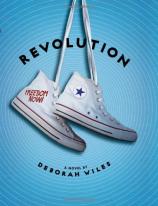Revolution
Review
Revolution
REVOLUTION by Deborah Wiles is the second book in The Sixties Trilogy. COUNTDOWN, the first book in the trilogy, was published in 2010. Set in 1962, it highlights the events of the Cuban Missile Crisis. The events in REVOLUTION happen in Greenwood, Mississippi during the summer of 1964. This would come to be known as Freedom Summer because it was the season that civil rights workers converged on the state to encourage the African-American population to register to vote and to claim the equal rights they had been denied.
The events of Freedom Summer are seen primarily through the eyes of Sunny, a 12-year-old girl from Greenwood. Sunny quickly gets caught up in the happenings of Freedom Summer, as no one’s life went untouched during this turbulent time. Sunny struggles with accepting her new stepmother while continuing to long for her own mother, who left when Sunny was young. Sunny must also learn to live with a new stepbrother and stepsister, who bring both joy and frustration. Between attending Vacation Bible School, seeking adventures and fanning her love of the Beatles with her best friends, Polly and Margaret Mary, Sunny has a full summer.
But Sunny’s summer and life change as the impacts of Freedom Summer hit closer and closer to home. Her plans to swim in the town pool on a daily basis are thwarted, when, in defiance of the Civil Rights Act of 1964, the town closes it in order to prevent equal access to both whites and blacks. After selling tickets to black moviegoers, the local movie theater is attacked and Sunny is forbidden from going to see her beloved uncle and the movies she loves so much because of the instability. Wiles is a master of creating relatable characters, and experiencing these events through Sunny likely makes them more relevant and understandable to readers.
"Wiles is a master of creating relatable characters."
Although the vast majority of the story is told through Sunny’s perspective, there are a few chapters that are told from the point of view of Sunny’s slightly older stepbrother, Gillette, and a handful from the viewpoint of Raymond Bullis, a 15-year-old African-American boy. The chapters from Gillette’s perspective hint at his life before becoming Sunny’s stepbrother, which included an abusive father, but they provide an incomplete picture of this time period and don’t serve to illuminate the current events in the story. Additionally, there are so few chapters from Gillette’s point of view that they are a distraction when they do appear.
The chapters from Ray’s standpoint add more to the narrative by giving parts of the story from the “other side.” For example, Ray is the first person to attend a show at the white movie theater. The resulting events are told from both his side and Sunny’s side, which provides a more nuanced understanding of the incident. These chapters add to the storyline and at times I wished there were more chapters from Ray’s perspective.
Both COUNTDOWN and REVOLUTION have been called documentary novels because Wiles intersperses images and documents from the time period throughout the narrative. These pictures and documents serve to provide texture and depth to the events in the story as well as grounding the reader in the facts and events of the time period. These interludes of historical documents make the reading experience unique. However, several of these interludes in REVOLUTION are extremely text heavy and others are quite lengthy. At times I felt like they interrupted the story too much. I also have to wonder if younger readers will be intimidated by the amount of text in some of these interludes and skip them entirely or lose interest in the story. I can imagine that Wiles had to make many difficult decisions about what to include in these parts, and the balance between providing historical context and supporting the story is no doubt a delicate one; I feel that in many instances the balance favored historical context as opposed to the story.
Reviewed by Aimee Rogers on June 5, 2014
Revolution
- Publication Date: May 27, 2014
- Genres: Children's, Fiction, Historical Fiction, Young Adult 11+
- Hardcover: 544 pages
- Publisher: Scholastic Press
- ISBN-10: 0545106079
- ISBN-13: 9780545106078





